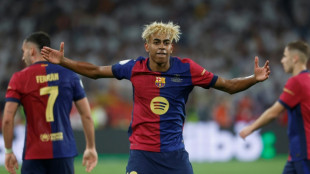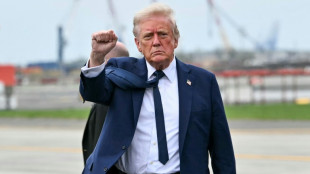
-
 US climate assessment thrown into doubt as Trump dismisses authors
US climate assessment thrown into doubt as Trump dismisses authors
-
Venezuelan president slams US over little girl's 'abduction'

-
 Hard-right upstarts eye big gains in local UK polls
Hard-right upstarts eye big gains in local UK polls
-
Skulls, smoke and spirits: Thai ceremony for the unclaimed dead

-
 Canada's Carney: political newcomer who says he's best in a crisis
Canada's Carney: political newcomer who says he's best in a crisis
-
Cavaliers scorch Heat to seal series sweep

-
 Dead salmon create election stink on Australian island
Dead salmon create election stink on Australian island
-
Mic check: Singapore's podcast boom amplifies opposition voices

-
 Markets rise as traders gear up for earnings, key jobs data
Markets rise as traders gear up for earnings, key jobs data
-
Congress passes 'revenge porn' ban, sending it to Trump

-
 Spain and Portugal work to restore power after massive blackout
Spain and Portugal work to restore power after massive blackout
-
Less-thirsty rice offers hope in drought-stricken Chile

-
 Yamal stardust could give Barca edge on Inter Milan
Yamal stardust could give Barca edge on Inter Milan
-
Trump targets US 'sanctuary cities' in migrant crackdown

-
 Mexico agrees to send water to US after Trump threatens tariffs
Mexico agrees to send water to US after Trump threatens tariffs
-
Amazon launches first Starlink-rival internet satellites

-
 US lost seven multi-million-dollar drones in Yemen area since March
US lost seven multi-million-dollar drones in Yemen area since March
-
Bucks blow as Lillard suffers torn Achilles: team

-
 Putin orders three-day truce amid new US warnings
Putin orders three-day truce amid new US warnings
-
Real Madrid's Ancelotti agrees Brazil deal - reports

-
 ChatGPT adds shopping help, intensifying Google rivalry
ChatGPT adds shopping help, intensifying Google rivalry
-
Global stocks mixed amid trade hopes as markets await tech earnings

-
 Commanders heading back to D.C. after inking $3.7 bln stadium deal
Commanders heading back to D.C. after inking $3.7 bln stadium deal
-
US warplane falls off aircraft carrier into Red Sea

-
 Feisty Arteta urges Arsenal fans to 'bring boots' to PSG Champions League clash
Feisty Arteta urges Arsenal fans to 'bring boots' to PSG Champions League clash
-
Bucks blow as Lillard suffers ruptured Achilles: reports

-
 No power, no phone, no transport -- Spain in a panic
No power, no phone, no transport -- Spain in a panic
-
US warplane went overboard into Red Sea: Navy

-
 'Like a dream' as IPL's 14-year-old Suryavanshi becomes youngest to hit T20 ton
'Like a dream' as IPL's 14-year-old Suryavanshi becomes youngest to hit T20 ton
-
Luis Enrique says PSG have improved since October Arsenal loss

-
 UN food, refugee agencies warn of huge cuts after funding losses
UN food, refugee agencies warn of huge cuts after funding losses
-
Trump trade war dominates BRICS meeting in Brazil

-
 Rashford expected to miss rest of Aston Villa season
Rashford expected to miss rest of Aston Villa season
-
IPL's 14-year-old Suryavanshi youngest to hit T20 ton as Rajasthan rule

-
 Halle Berry, Jeremy Strong to join Cannes film festival jury: organisers
Halle Berry, Jeremy Strong to join Cannes film festival jury: organisers
-
Klopp congratulates Liverpool on Premier League triumph

-
 Violence-weary Trinidadians vote in general election
Violence-weary Trinidadians vote in general election
-
Abuse scandal in focus in search for new pope

-
 Prince William and Kate mark wedding anniversary in Scotland
Prince William and Kate mark wedding anniversary in Scotland
-
Amazon set for launch of Starlink-rival satellites

-
 London mayor Sadiq Khan targets Olympic history for city
London mayor Sadiq Khan targets Olympic history for city
-
Stock markets diverge amid trade hopes, ahead of earnings

-
 Canada votes as Trump renews US takeover push
Canada votes as Trump renews US takeover push
-
Massive blackout hits all of Spain and Portugal

-
 Conclave starts May 7, cardinals say new pope must tackle abuse
Conclave starts May 7, cardinals say new pope must tackle abuse
-
BRICS ministers meet in Brazil over Trump trade policies

-
 Trump escalates immigration crackdown to mark 100 days
Trump escalates immigration crackdown to mark 100 days
-
Outkast, White Stripes, Cyndi Lauper among Rock Hall inductees

-
 Putin orders three-day truce in May but Ukraine asks 'Why wait?'
Putin orders three-day truce in May but Ukraine asks 'Why wait?'
-
Eubank Jr discharged from hospital following boxing grudge match


Noxious fumes at night aren't a pollinating moth's delight
Certain plants have flowers that open only in the evening, and depend on nocturnal pollinators such as moths to thrive.
But a new paper published in Science on Thursday finds an atmospheric pollutant that is much more prevalent at night drastically reduces the fluttering creatures' ability to track floral scents.
It adds to a growing understanding of how human activities, including not just air but also light and noise pollution, are negatively impacting the natural world.
"Our impacts on the environment are affecting human health, etc, that we tend to concentrate on, but they're also affecting ecosystem functioning through these plants and pollinators," senior author Jeff Riffell, a biology professor at the University of Washington, told AFP.
Riffell said the role of nitrate radicals (NO3) on flower scents hadn't been well studied, because the chemical is around at night and prior research focused on the impacts of pollution on daytime pollinators like bees.
Nitrate radicals form when nitrogen dioxide reacts in the atmosphere with ozone -- both of which come from burning fossil fuels, and have natural sources too.
Unlike nitrogen dioxide and ozone, however, nitrate radicals rapidly degrade in sunlight, making them virtually absent in daytime.
For their study, Riffell and colleagues chose the pale evening primrose (Oenothera pallida), a wildflower that grows in arid settings across the western United States.
Its white flowers emit a strong, piney scent that attracts the white-lined sphinx moth (Hyles lineata) and the tobacco hawk moth (Manduca sexta), species which use their powerful antennae to sniff out pollen from miles away.
- Pollinator crisis -
First, the team chemically analyzed the wildflower's scent to unravel its chemical recipe, revealing a complex bouquet of chemicals.
Next, they separated out the individual chemicals and exposed them one at a time to the moths, to determine exactly which ones were responsible for attracting the winged insects.
This revealed a subset of the chemicals, known as monoterpene compounds, were largely responsible for the scent, and further tests showed that nitrate radicals decimated the levels of these compounds.
Finally, the team carried out wind tunnel experiments involving the moths and the scent chemicals that they emitted at controlled levels from a fake flower.
"What we found is that the moths really were very sensitive to the flower scent and would kind of navigate upwind and try to feed from this artificial flower," said Rifell.
"But if we added NO3, then all of a sudden, for one species of moth, it totally eliminated their ability to recognize the flower. And for another species, it reduced their attraction to the flower by 50 percent."
The nitrate radicals were comparable to those found at night in a typical urban environment, modeled on Seattle. When the team ran the experiment with the pollutants typically present during the day, they saw far less of an impact.
Overall, the experiment revealed a strong impact on pollination activity, at a time when the world's pollinators are in crisis.
Around three-quarters of the more than 240,000 species of flowering plants depend on pollinators, and over 70 pollinator species are endangered or threatened, said Rifell.
The team also ran computer simulations to determine which parts of the world would be most likely to experience problems as a result of this effect.
Areas identified include much of Europe, the Middle East, Central and South Asia, and southern Africa.
"Outside of human activity, some regions accumulate more NO3 because of natural sources, geography and atmospheric circulation," said co-senior author Joel Thornton, a professor of atmospheric sciences.
"But human activity is producing more NO3 everywhere. We wanted to understand how those two sources — natural and human — combine and where levels could be so high that they could interfere with the ability of pollinators to find flowers."
F.Bennett--AMWN
